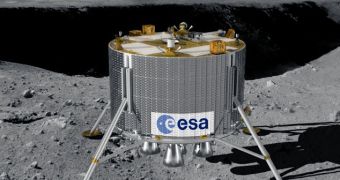The proposed lander that ESA wants to send to the Moon has recently made an important step forward, when representatives from the organization signed a critical contract with EADS-Astrium.
The Berlin, Germany-based company will assist the European Space Agency in developing a mission that will act as a precursor for planned manned exploration of Earth's natural satellite.
Europe plans to land astronauts at the lunar south pole, but the terrain in the area is extremely rugged, with only a limited number of plateaus or other landscape features that would support a lander.
Nevertheless, this is where future missions will have to land, due to the widespread availability of water ice. Future astronauts will not be able to survive on the Moon without access to these deposits.
Several essential chemicals can be made from water ice, including hydrogen-based rocket fuel, oxygen for life support systems, and water for human colonists.
But water ice can only be found at the bottom of permanently-dark craters, which are surrounded by natural defenses such as dangerous boulders and high ridges. Yet ships need to land close by.
The purpose of the ESA lander demonstrator is to show that such a mission is not impossible. In other words, it will be deployed to set the stage for future manned landings.
A probe is to be sent to the lunar surface by no later than 2018, ESA's current plans state. The effort is a part of the “Global Exploration Strategy,” which was agreed upon by 14 space agencies.
“It is a great pleasure to see progress being made in Europe in the field of space exploration relying on key technologies developed for human spaceflight,” said at the ceremony Simonetta Di Pippo.
The official is the ESA Director of Human Spaceflight. She signed the new contract with EADS-Astrium representative Michael Menking.
Also present at the ceremony will be Peter Hintze, who is the Parliamentary State Secretary in the German Federal Ministry of Economics and Technology.
“As we prepare ourselves to join the US, Russia and Japan in the decision to utilize the International Space Station for 10 more years and beyond, we are preparing the next steps and we are working to position Europe at the level of its competences and capabilities within the global exploration undertaking,” Di Pippo added.
“With a strong and successful presence in low orbit, the Moon is the next natural goal on our common path to further destinations,” she went on to say.
“Europe is actively and successfully present in these global projects, like ISS and exploration, which contribute to affirm our role as a modern, dynamic and innovation-driven continent,” the official said.

 14 DAY TRIAL //
14 DAY TRIAL //